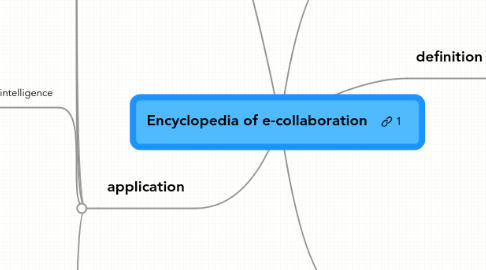
1. application
1.1. research
1.1.1. weblog
1.1.1.1. type
1.1.1.1.1. filter
1.1.1.1.2. personal journal
1.1.1.2. capabilities
1.1.1.2.1. knowledge blog
1.1.1.3. use
1.1.1.3.1. supporting community forming
1.1.1.3.2. helping to find other competent people with relevant work
1.1.1.3.3. facilitating connections between researchers
1.1.1.3.4. making it possible to obtain speedy feedback on ideas
1.1.1.3.5. fostering diversity and allowing for radical new ideas to be acknowledged, circulated and discussed
1.1.1.3.6. fostering communication and collaboration between researchers from different fields
1.1.1.3.7. supporting the initiation and development of conversations
1.1.1.4. underlying assumption
1.1.1.4.1. since scientific knowledge is socially constructed, scientific knowledge creation is collaborative in nature
1.2. business
1.2.1. adaptive workforce
1.2.1.1. change areas
1.2.1.1.1. globalization
1.2.1.1.2. interpersonal interaction
1.2.1.1.3. knowledge work
1.2.1.2. adaptive performance
1.2.1.2.1. influences culture
1.2.2. procurement
1.2.2.1. maturity model stages
1.2.2.1.1. transactional orientation
1.2.2.1.2. commercial orientation
1.2.2.1.3. purchasing coordination
1.2.2.1.4. internal integration
1.2.2.1.5. external integration
1.2.2.1.6. value chain integration
1.2.2.2. e-procurement systems implementation is positively correlated with the performance of buyer-supplier interaction
1.3. ambient intelligence
1.3.1. ubiquitous computing
1.3.2. ubiquitous communications
1.3.3. Intelligent user interfaces (user adaptive interfaces)
1.3.3.1. personalized adaption
1.4. leadership
1.4.1. Ambassadorial behaviors
1.4.1.1. internal boundary spanning
1.4.1.1.1. Promote relationship building between close and distant team members by encouraging sharing of personal information
1.4.1.1.2. Educate local team members on differences in cultural values and communications styles of remote members
1.4.1.1.3. Establish key relationships with members at remote locations who can serve as mentors and coaches
1.4.1.1.4. Ensure that the vision is clear by working through key remote members
1.4.1.1.5. Ensure that communications are consistent with local style
1.4.1.1.6. Serve as a mediator in inter-organizational conflict
1.4.1.1.7. Help establish and reinforce a common set of norms through members at remote locations Establish a member exchange between close and distant groups.
1.4.1.2. external boundary spanning
1.4.1.2.1. Formulate strategic plan with distant members to develop ambassadorial status with their close external groups.
1.4.1.2.2. Promote strategy of team advocate with key distant members.
1.4.1.2.3. Encourage team advocate to serve as a mediator in cases of conflict with external group.
1.4.1.2.4. Encourage team advocate to buffer external demands placed on the team.
1.4.1.2.5. Develop understanding of resources available from external groups.
1.4.1.2.6. Communicate external group's suggestions, needs, and concerns to VTL.
1.4.1.2.7. Establish communication channel to ensure knowledge base is kept current.
1.4.1.3. shared leadership
1.4.1.3.1. Create conditions for shared leadership at distant locations
1.4.1.3.2. Establish key relationships with members at remote locations who can serve as mentors and coaches
1.4.1.3.3. Establish a member exchange between close and distant groups.
1.4.1.4. impression management
1.4.1.4.1. Monitor conflicts and problems between close and distant members
1.4.1.4.2. Serve as a mediator in cases of conflict.
1.4.1.4.3. Recognize member's contribution to team efforts internally.
1.4.1.4.4. Acknowledge team's contribution to organizational strategy externally.
1.4.1.4.5. Monitor expectations (internal and external) and ensure alignment with reality.
1.4.2. virtual teams
1.4.2.1. distance
1.4.2.1.1. geographic
1.4.2.1.2. emotional
1.4.2.1.3. social
1.4.2.2. Untitled
2. New node
3. collaboration tools
3.1. browser-based
3.1.1. WebEx
3.1.2. Ubidesk
3.2. not browser-based
3.2.1. peer-to-peer
3.2.1.1. Groove
3.2.2. client-server
3.2.2.1. MSN
3.2.2.2. ICQ
3.3. trends
3.3.1. many subcommunities
3.3.1.1. asynchronous learning networks
3.3.1.2. virtual social networking
3.3.2. integrating communities
3.3.2.1. compensatory adaptation
3.3.2.2. collaborative sense making
4. definition
4.1. collaboration among individuals engaged in a common task using electronic technologies
4.1.1. broader than
4.1.1.1. computer-mediated communication
4.1.1.2. computer-supported cooperative work
